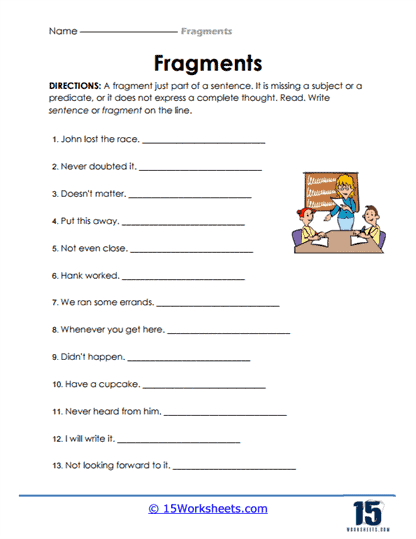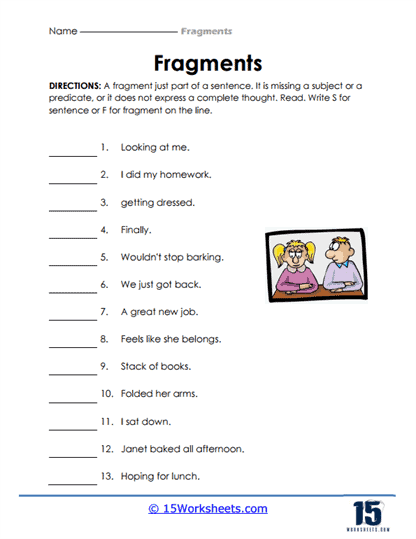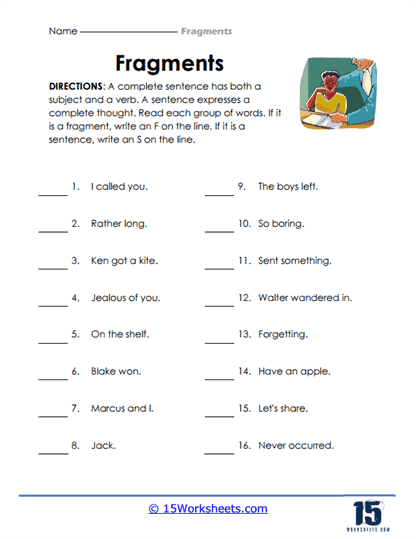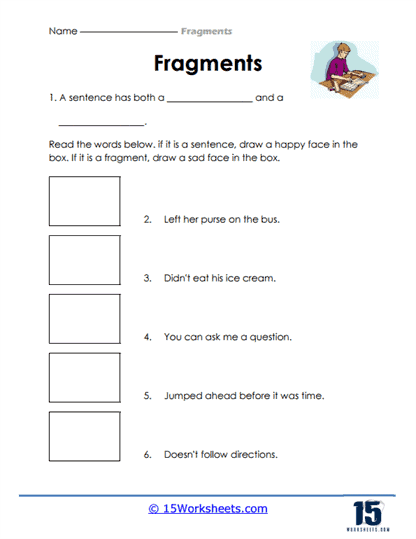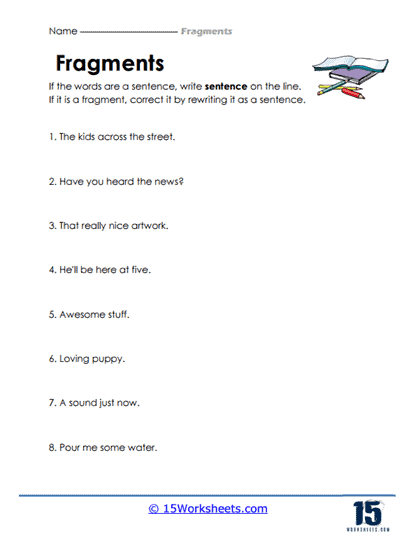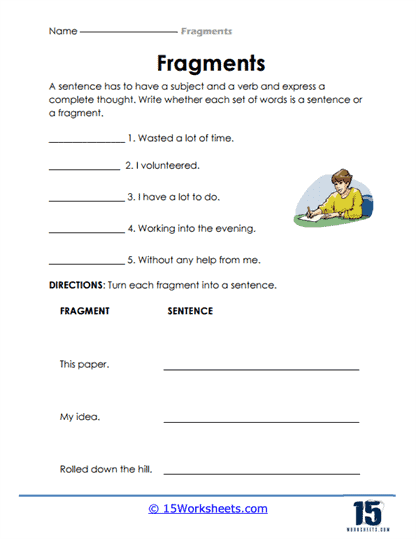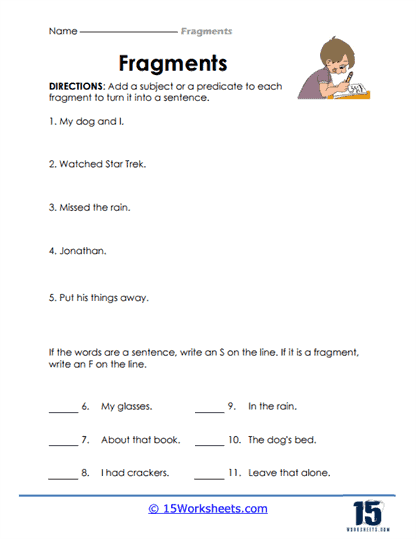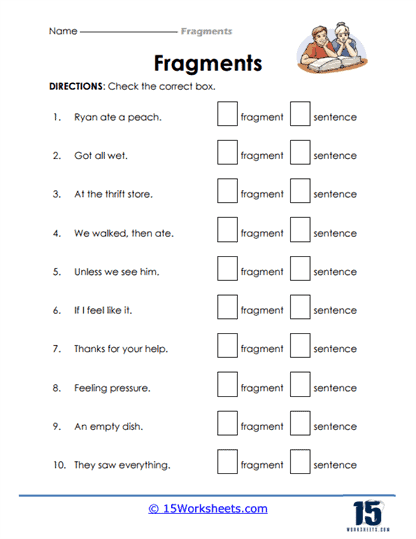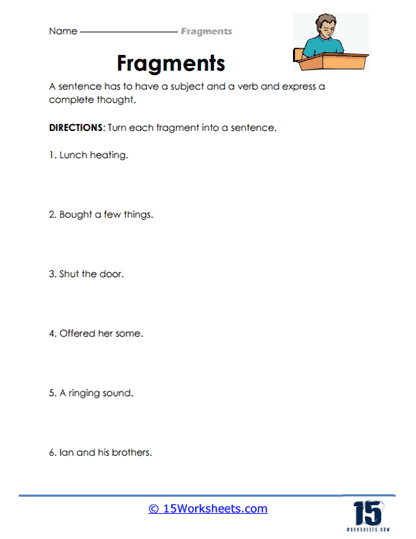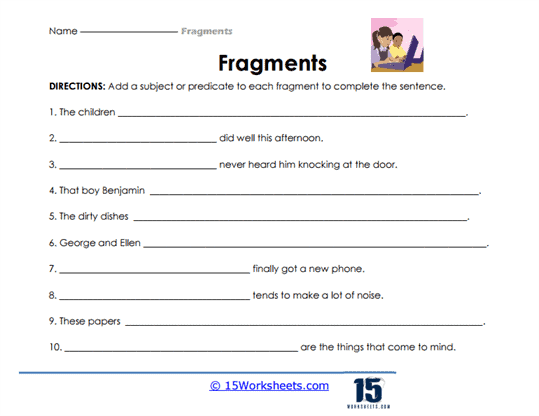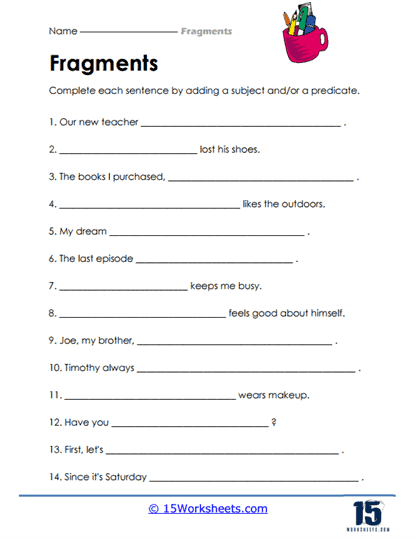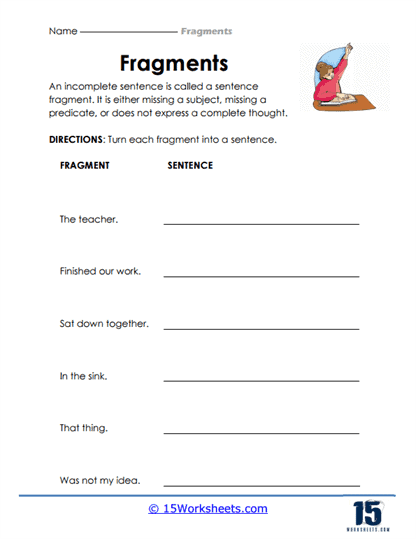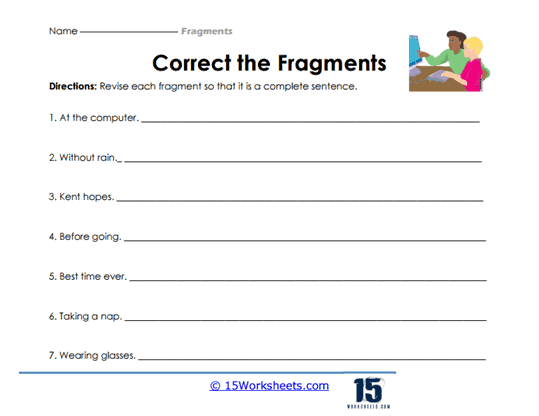Fragments Worksheets
All About These 15 Worksheets
A sentence fragment is an incomplete sentence that does not express a complete thought. It may lack a subject, a verb, or both, or it may be a subordinate clause without a main clause.
Sentence fragment worksheets typically include various exercises or prompts that require students to:
Identification – Students are given a set of sentences and they have to determine whether each sentence is a complete sentence or a fragment. This activity helps students understand the characteristics of complete sentences and recognize common errors that result in sentence fragments.
Complete Them – Students are given sentence fragments and they need to rewrite them to make them complete sentences. This activity encourages students to identify and add missing subjects, verbs, or other necessary components to create grammatically correct and meaningful sentences.
Sentence Reconstruction – Students are given a paragraph or passage that contains sentence fragments, and they have to rewrite the text by incorporating the fragments into complete sentences. This exercise helps students practice integrating fragments into a cohesive and coherent piece of writing.
Contextual Analysis – Students are presented with paragraphs or passages and they have to identify and revise sentence fragments to improve the overall clarity and readability of the text. This activity helps students develop their editing and revision skills by recognizing and correcting errors in sentence structure.
Writing Complete Sentences – Students are given prompts or topics, and they have to write complete sentences that effectively convey their ideas. This exercise encourages students to apply their understanding of sentence fragments in their own writing and reinforces the importance of expressing complete thoughts.
What are Sentence Fragments?
Sentence fragments are incomplete sentences that lack one or more essential elements, such as a subject or a verb, and do not express a complete thought on their own. They can occur due to various reasons, such as missing subject or verb, improper subordination, or sentence structure errors. Sentence fragments often disrupt the flow and clarity of writing.
Here are a few examples of sentence fragments:
“Running through the park on a sunny day.”
This fragment lacks a subject and a verb. It does not form a complete thought or convey a clear idea.
“Because he arrived late to the meeting.”
This fragment is a subordinate clause without a main clause. It lacks a verb and does not express a complete thought on its own.
“The book with the red cover and intricate illustrations.”
This fragment lacks a verb. It provides a description but does not express a complete idea or action.
“In the middle of the night, during a thunderstorm.”
This fragment is another example of a subordinate clause without a main clause. It lacks a subject and verb to form a complete thought.
It’s important to note that not all sentence fragments are grammatically incorrect or unacceptable in certain contexts, such as creative writing or dialogue. However, in most formal writing situations, including academic essays or professional communication, sentence fragments should be avoided. It is crucial to ensure that sentences express complete thoughts and include both a subject and a verb.
What are 4 Types of Fragments?
Subordinate Clauses
These fragments are incomplete because they contain a subordinate clause (also known as a dependent clause) without a main clause. Subordinate clauses rely on main clauses to form complete sentences.
Example – “Although she studied all night.”
In this fragment, “Although she studied all night” is a subordinate clause, but it lacks a main clause to provide the complete thought or action.
Verb Phrases
These fragments lack a subject and only consist of a verb or a verb phrase. A subject is necessary for a sentence to express a complete thought.
Example – “Running to catch the bus.”
In this fragment, “Running to catch the bus” lacks a subject, and therefore, it does not form a complete sentence.
Appositives
These fragments occur when an appositive (a noun or noun phrase that renames or identifies another noun) is used without a main clause.
Example – “My friend Lisa.”
In this fragment, “My friend Lisa” is an appositive that renames the noun “friend,” but it lacks a main clause to complete the sentence.
Infinitive Phrases
These fragments consist of an infinitive verb form (to + verb) without a subject or main clause. Infinitive phrases need a subject and a main clause to function as complete sentences.
Example – “To travel around the world.”
In this fragment, “To travel around the world” is an infinitive phrase, but it does not have a subject or main clause to express a complete thought.
How To Fix Fragmented Sentence
To fix a fragmented sentence, you need to revise it by adding the necessary components to make it a complete sentence that expresses a clear and complete thought. Here are a few ways to fix fragmented sentences:
Step 1: Add a Subject
If the fragment lacks a subject, add a noun or pronoun to establish who or what is performing the action.
Fragment: “Running through the park on a sunny day.”
Revised: “I was running through the park on a sunny day.”
Step 2: Add a Verb
If the fragment lacks a verb, include an action word to indicate the action or state of being.
Fragment: “The book with the red cover and intricate illustrations.”
Revised: “The book with the red cover and intricate illustrations caught my attention.”
Step 3: Connect the Fragment to a Main Clause
If the fragment is a subordinate clause or dependent clause, connect it to a main clause to form a complete sentence.
Fragment: “Because he arrived late to the meeting.”
Revised: “Because he arrived late to the meeting, he missed the important discussion.”
Step 4: Combine Fragments
If you have multiple fragments, combine them into a single, complete sentence by adding the necessary subject, verb, and connecting words.
Fragments: “In the middle of the night. During a thunderstorm.”
Revised: “In the middle of the night, during a thunderstorm, we decided to stay indoors.”


